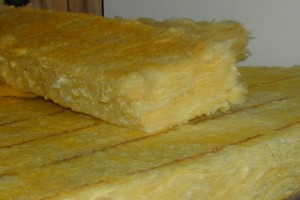Fibrous insulation

Fibrous insulation is a specific type of insulation that works by capturing air within the fibers, preventing heat transmission through convection. This type of insulation also limits heat conduction between molecules of gases by minimizing collisions between the particles. Because they have a porous structure, this type of insulation also is good at soundproofing and can be used in acoustics insulation. Generally speaking fibrous insulation is flexible but with additives can be made rigid and formed to specific shapes.[2]
Types of Fibrous Insulation
There are numerous different types of fibrous insulation, each having their own benefits and drawbacks. Some common types are:[3]
- Fiberglass: This type of insulation is composed of extremely fine fibers of glass and comes in rolls or loose-fill. Fiberglass insulation comes in many densities with different associated R-values and can be used in areas with limited space for insulation. Fiberglass insulation is made from molten glass that is spun or blown into fibers.
- Mineral wool: This type of insulation is man made and consists of natural minerals or minerals left over from use of molten metal. It contains a significant amount of industrial recycled content and doesn't require any extra chemicals to make it fire retardant. Mineral wool insulation comes in rolls or loose-fill.
- Cellulose: Cellulose insulation is made of recycled paper products - such as newsprint. The paper used is cut into small pieces and then fiberized and packed into cavities. Chemical compounds, such as mineral borate, can be added to increase fire resistance.
- Plastic Fiber: This type of insulation is mainly made from recycled plastic bottles - composed of PET, a type of plastic - and the fibers formed are pressed into batt insulation. Plastic fiber insulation is similar to fiberglass insulation and is generally treated to make it more fire resistant, although it does still melt.
- Natural Fiber: Some natural fibers including cotton, wool, straw, and hemp are used as insulation materials. Cotton insulation is nontoxic, but is more costly than fiberglass insulation and must be treated with borate to make it flame retardant. Wool must also be treated with borate, but can hold large amounts of water which can remove this flame resistant coating. Wool has a similar R-value as other more common types of insulation. Hemp insulation is relatively unknown and not used widely, but has a similar R-value to other types of fibrous insulation.
Precautions
Fibrous insulation such as glass fibre and mineral wool can be irritating to the skin, eyes, and respiratory system. Caution should be taken to not touch this type of insulation with bare hands. Instead, thick long sleeve clothing should be worn with gloves to minimize contact.[4]
As well, older homes may contain asbestos or vermiculite insulation which can appear to be fibrous. These types of insulation are determined to be unsafe to have in a home and should be removed by professionals when found in a home without being disturbed.[4]
References
- ↑ Radomil. (May 19, 2015). Glass Wool Insulation [Online]. Available: http://commons.wikimedia.org/wiki/File:Glass_wool_insulation.jpg#/media/File:Glass_wool_insulation.jpg
- ↑ Euroguarco. (May 19, 2015). Fibrous Insulating Materials [Online]. Available: http://www.euroguarco.com/en/insulation/20_10_10
- ↑ Energy.gov. (May 19, 2015). Insulation Materials [Online]. Available: http://energy.gov/energysaver/articles/insulation-materials
- ↑ 4.0 4.1 Natural Resources Canada. (May 19, 2015). Keeping the Heat In [Online]. Available: http://www.nrcan.gc.ca/sites/www.nrcan.gc.ca/files/energy/pdf/housing/Keeping-the-Heat-In_e.pdf

